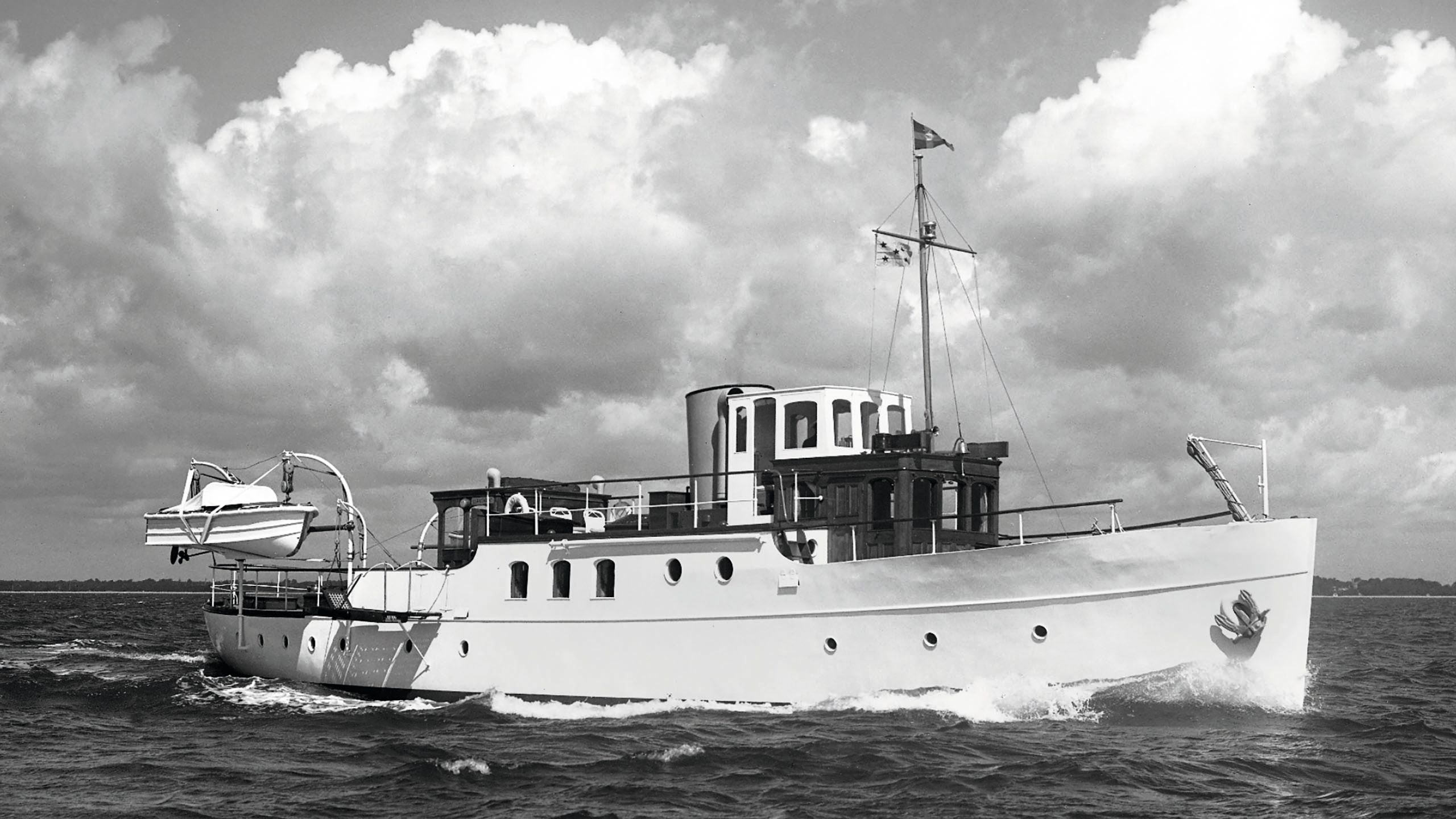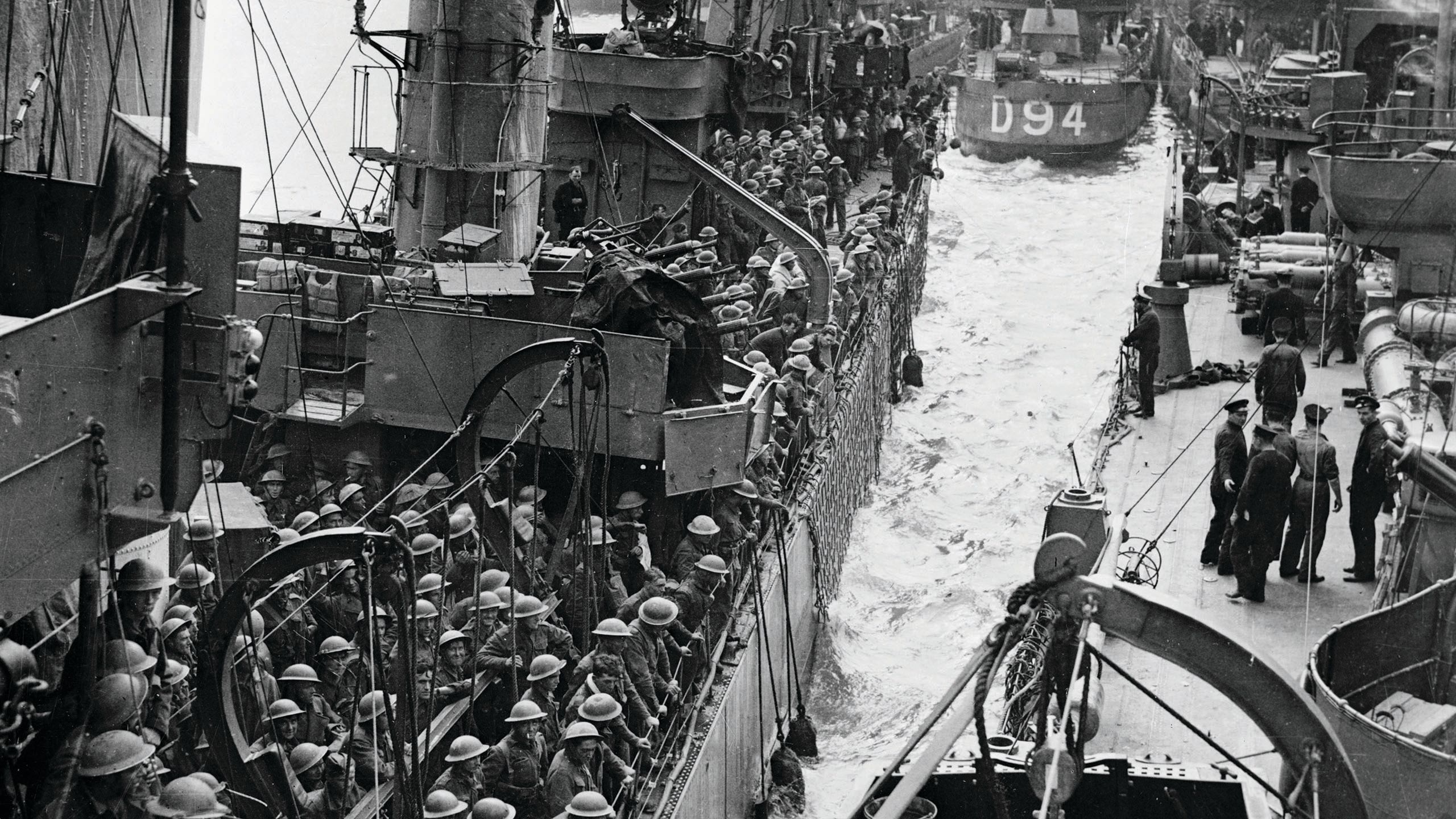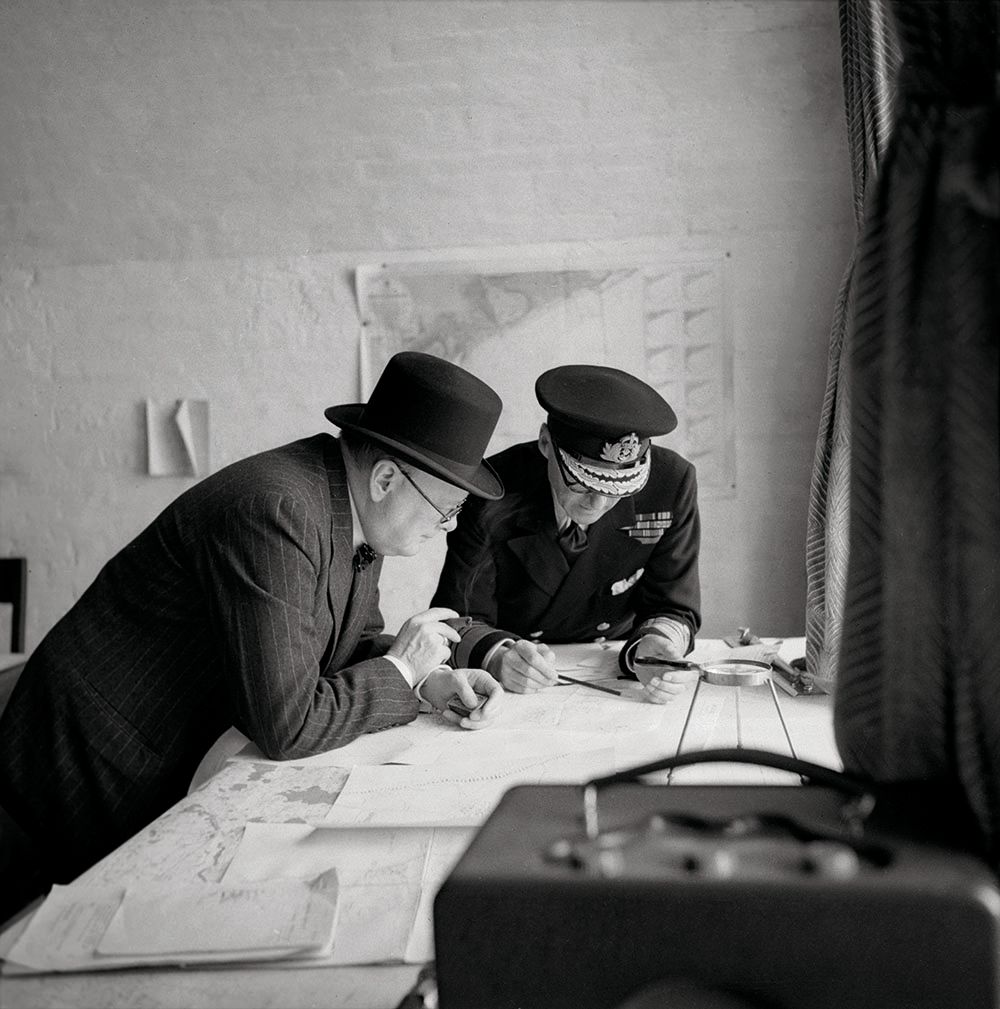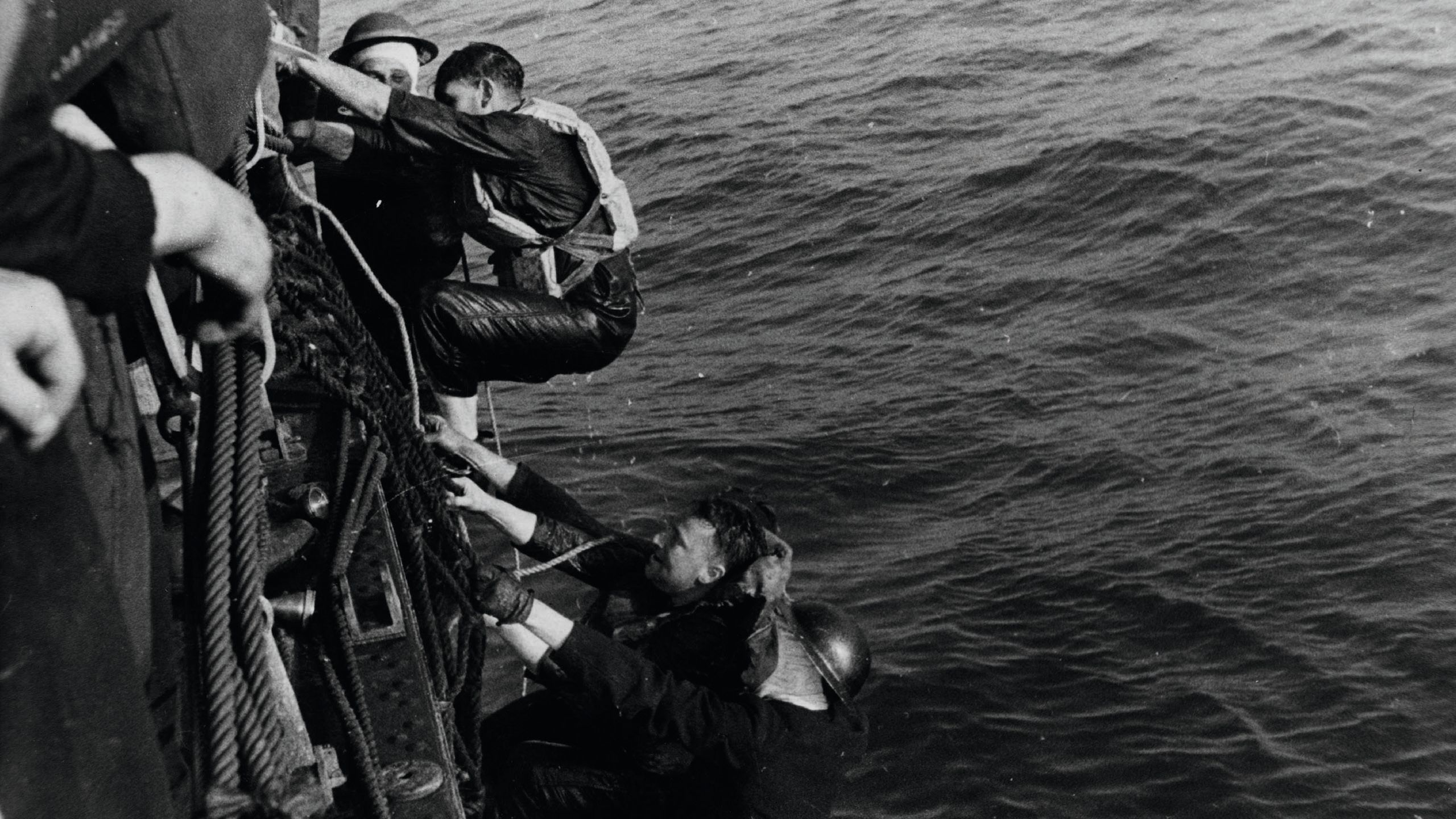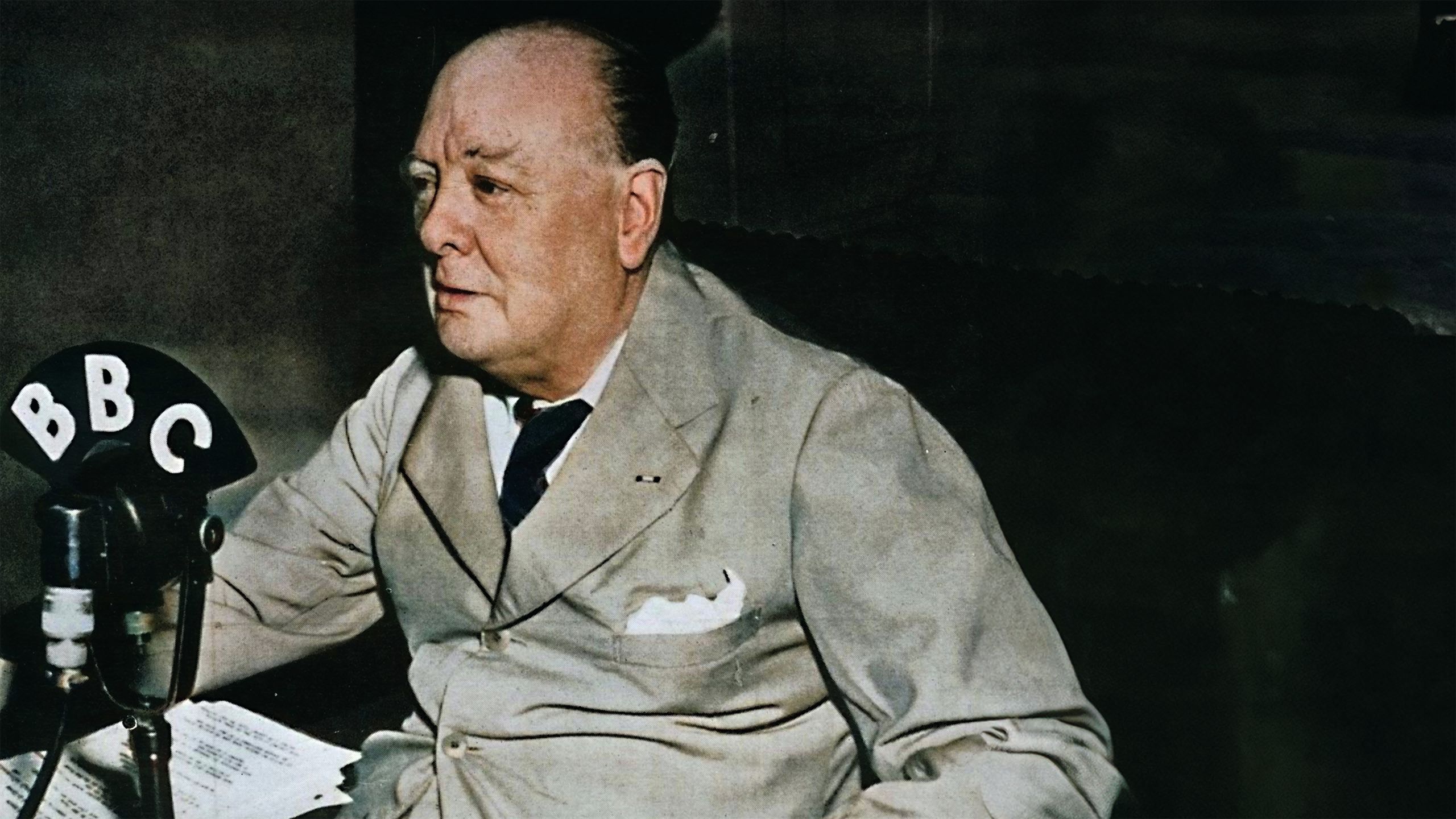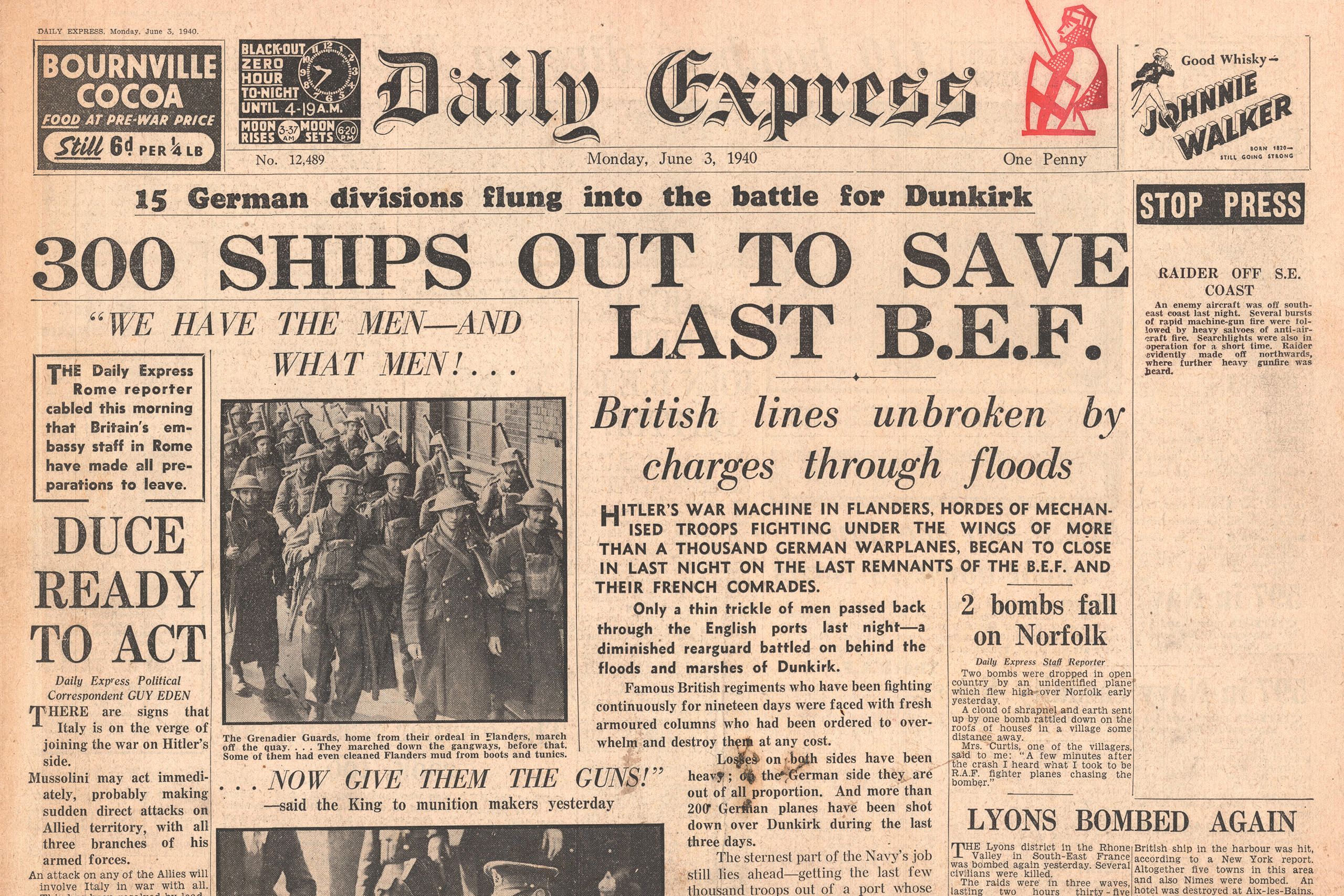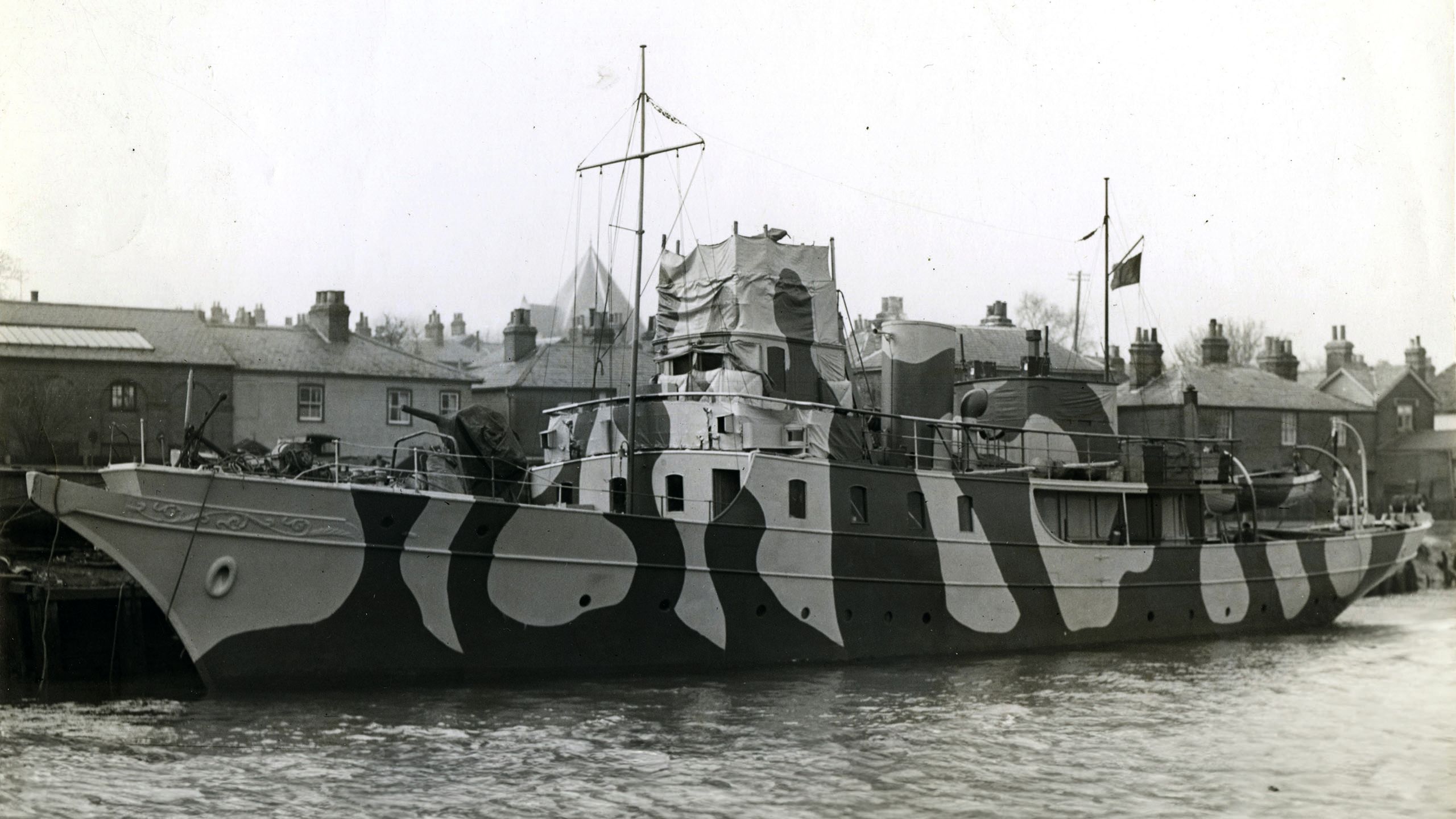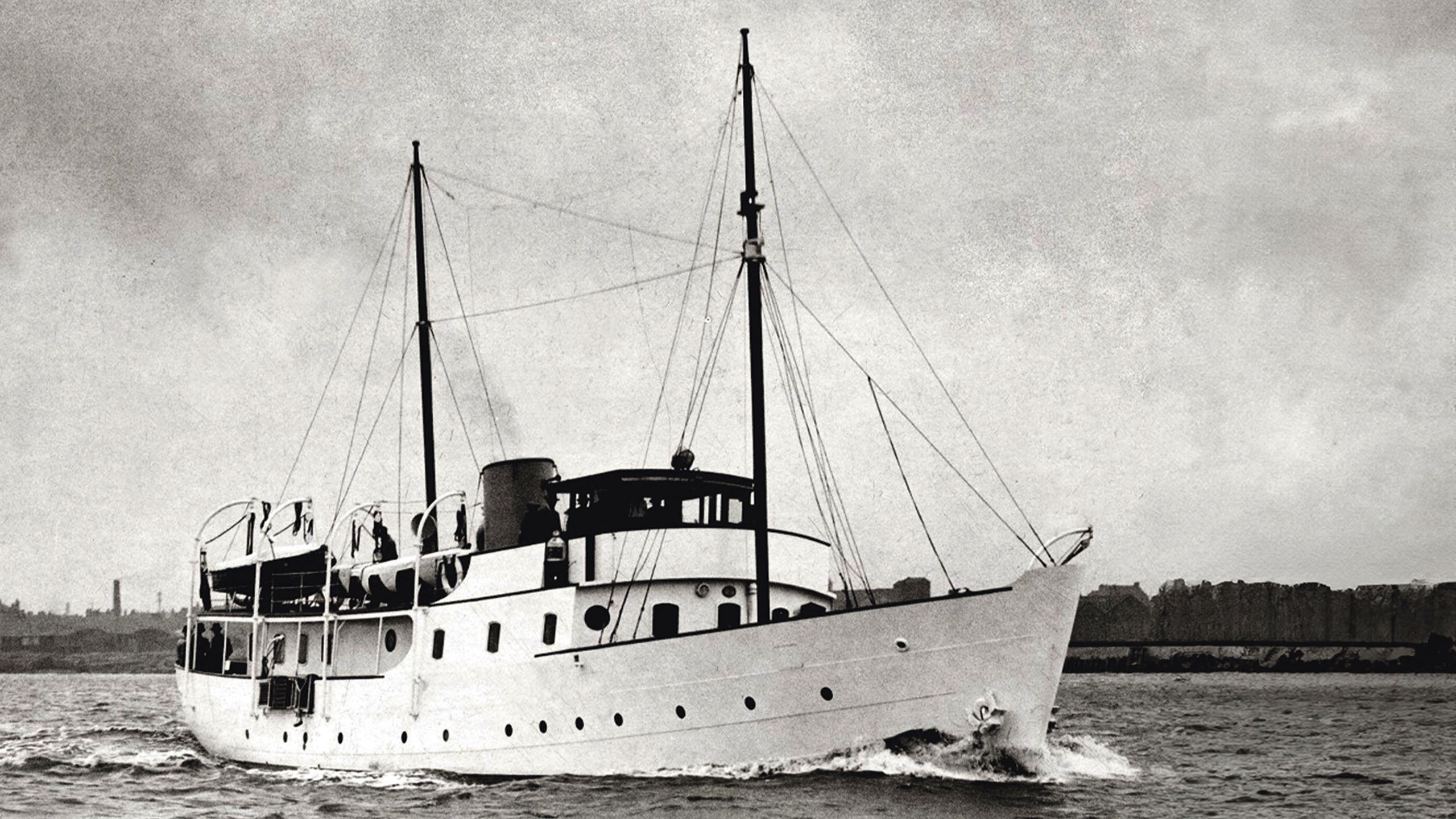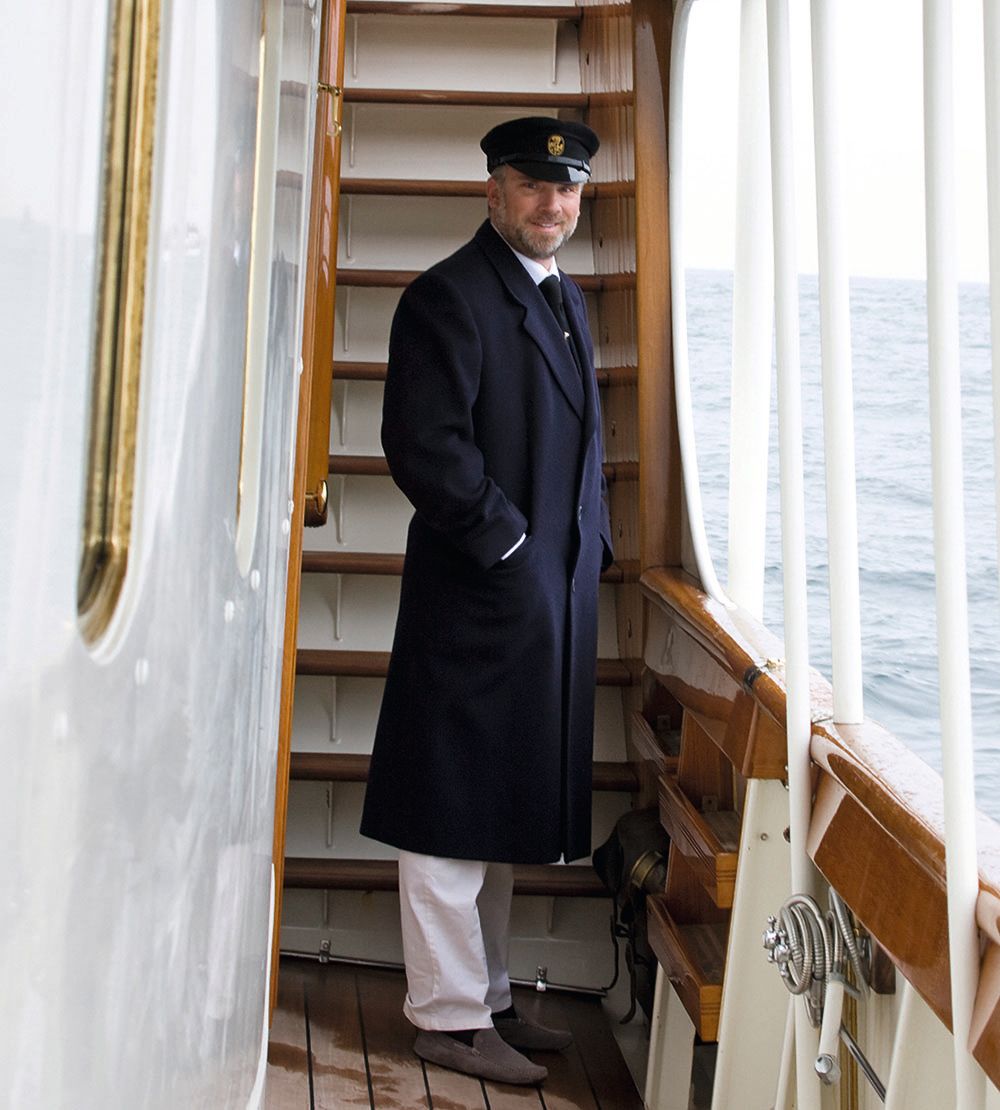HEROIC SPIRIT
On the 85th anniversary of Dunkirk, the Little Ships sail again

This year the Dunkirk Little Ships returned to the site of the action. Nick Shepley looks at three of the yachts that made the journey, to discover the fascinating lives they’ve led and how modern owners are still adding to their stories
JOHN FROST NEWSPAPERS - ALAMY STOCK PHOTO
OIt was a very shallow beach, and at low tide the water went out a long way,” recalled Rear Admiral Robert Timbrell of Llanthony, the yacht he had captained at the tender age of 20. “We were being shelled by the Germans, the town was in flames.”
If the introduction of his reminiscence suggests a hazy tropical holiday, the conclusion places it squarely in a very different location. A war-torn beach in Normandy is not a locale that the yacht’s owner could have envisioned for Llanthony when he took delivery of her five years before the outbreak of the Second World War.
Llanthony in 1950
Llanthony in 1950
But while the originating essence of a yacht – the ideal or dream that lies behind its construction – is what first sets it afloat, there’s more to a boat’s spirit. What happens after, as different owners take their precious cargo on new adventures, is just as formative. And while all boats have spirit, some boats, like the Little Ships of Dunkirk, are suffused with it.
This year marks the 85th anniversary of Dunkirk, and many of these classic little ships are still brimful of that heroic spirit. In May every five years, these remaining Dunkirk Little Ships – there were more than 60 this year – are given the chance to sail the same return journey from Ramsgate in the UK to Dunkirk in France.
It is an opportunity to remember a particularly significant moment in their long and illustrious histories. And, unlike many of the mythologies and scandals surrounding particular yachts, the role played by these ships in Operation Dynamo is history. It is fact, not rumour.
PUTTNAM AND MALINDINE - IMPERIAL WAR MUSEUMS VIA GETTY IMAGES Some of the Little Ships delivered troops to destroyers such as these, in Dover on 31 May 1940
PUTTNAM AND MALINDINE - IMPERIAL WAR MUSEUMS VIA GETTY IMAGES Some of the Little Ships delivered troops to destroyers such as these, in Dover on 31 May 1940
Over the course of nine very real days, between 26 May and 4 June 1940, more than 800 little ships – yachts as well as merchant marine boats, fishing boats and lifeboats – recently requisitioned by the Royal Navy, made numerous trips from Ramsgate to Dunkirk.
The goal of Operation Dynamo was to evacuate British Expeditionary and Allied Forces who had been cut off and surrounded by German troops on the beaches and harbour of Dunkirk.
CAPT. HORTON - IMPERIAL WAR MUSEUMS VIA GETTY IMAGESPrime minister Winston Churchill, pictured with Vice Admiral Sir Bertram Ramsay, called the rescues “a miracle of deliverance”
CAPT. HORTON - IMPERIAL WAR MUSEUMS VIA GETTY IMAGESPrime minister Winston Churchill, pictured with Vice Admiral Sir Bertram Ramsay, called the rescues “a miracle of deliverance”
The flotilla of smaller vessels, which became known as the Little Ships of Dunkirk, was needed to ferry the soldiers from the shallow waters out to the waiting Navy destroyers and merchant ships, or all the way back to Ramsgate.
Above them, the RAF would fly more than 3,500 sorties to try and wrest air supremacy from the Luftwaffe , whose Ju 87s exacted a heavy toll on the boats below. The situation was, in the well-remembered words of Winston Churchill, “a colossal military disaster”, but the rescues provided by these Dunkirk Little Ships resulted in a “miracle of deliverance”.
PICTURE POST - HULTON ARCHIVE - GETTY IMAGESIn all, more than 338,000 soldiers in Dunkirk were rescued
PICTURE POST - HULTON ARCHIVE - GETTY IMAGESIn all, more than 338,000 soldiers in Dunkirk were rescued
One of these miracles was the 23.5-metre, steelhulled Llanthony, which Camper & Nicholsons designed and built just six years earlier, in 1934. The admiralty requisitioned Llanthony from its original owner, Welsh businessman, British Army officer and Tory MP Lionel Beaumont-Thomas, and transferred her to Ramsgate, where she was put under the command of Sub Lieutenant Robert Timbrell of the Royal Canadian Navy.
Timbrell was surprised to see that his vessel was to be a luxury yacht with no weapons, apart from an old First World War pistol (1914 Colt 45) and an uncorrected magnetic compass. Llanthony did carry two tenders, though, which could hold 16 soldiers, and she was big enough to carry 120 soldiers per trip. Over the course of the next week, she would rescue around 280 troops from Dunkirk. But the journeys took their toll.
We could take about 120 on each trip and our instructions were to return as soon as we were loaded,” then-Rear Admiral Timbrell, proud recipient of the Navy’s Distinguished Service Cross, told the Canadian Broadcasting Corporation years later.
“We did that for a couple of trips. Then, on the third or fourth trip, we got bombed. Although the RAF were doing a marvellous job, the odd German got through. We were hit on the fo’c’sle. I lost about five of my crew and both my anchors snapped. The fuel tanks were forward of the engine room and the fuel pipes were severed so that both engines died.”
THE PRINT COLLECTOR - HERITAGE IMAGES VIA GETTY IMAGES
THE PRINT COLLECTOR - HERITAGE IMAGES VIA GETTY IMAGES
They floated up on to the beach. “It all happened so quickly – one minute we were there and the next we were damaged, drifting and running aground.”
It was a sunny afternoon and there were shells falling all the way down the beach, which swarmed with thousands of Allied soldiers desperate to be taken back to England. It was day four of the evacuation and a stream of boats were going in and out.
The little ships had driven some trucks into the water to form a small jetty. This meant that, at high tide, they could go alongside the trucks and men could walk on top of them and jump aboard.
JOHN FROST NEWSPAPERS - ALAMY STOCK PHOTO
JOHN FROST NEWSPAPERS - ALAMY STOCK PHOTO
Still high and dry amid the chaos, Timbrell asked an English sergeant to drive a Bren Gun Carrier as far as he could in the water until the engine stopped, so that he could use it to anchor by. “That is what he did, and my two civilian diesel engineers repaired the fuel pipe, got the capstan going and winched us off,” recalled Timbrell. “They put a plate over my bombed fo’c’sle, and we sailed back to England.”
Llanthony returned to Dunkirk this year with the other remaining little ships to celebrate Operation Dynamo’s 85th anniversary. More than 200 ships were lost during those nine days, but despite new owners and new memories, those that still can, retrace their infamous journeys every five years.
And this year, with Llanthony fresh from a refit that enhanced her historic splendour, the yacht contingent presented perhaps a little extra vigour.

The steel hull of Llanthony still holds shrapnel from German bombs within it
Llanthony is not short of stories of scurrilous scandal. For a period, she was owned by one of the wealthiest families in the world, the Astors. John Jacob Astor was brought up at Cliveden House; he became the first Baron of Hever and upon the death of Lord Northcliffe in 1922, became chairman and proprietor of The Times.
Due to these links, Llanthony has been credited with offering a secret location for trysts between Wallis Simpson and Prince Edward in the 1930s, and then again in the 1960s with intimate assignations between Christine Keeler and John Profumo, who first met at the swimming pool of Cliveden.
BETTMANN - GETTY IMAGESWallis Simpson and Prince Edward reportedly met up on board for trysts
BETTMANN - GETTY IMAGESWallis Simpson and Prince Edward reportedly met up on board for trysts
The heroics of Dunkirk, however, are much more firmly established in Llanthony than the disproportionate attention given to the potential scandals taking place on board.
The steel hull of Llanthony still holds shrapnel from German bombs within it, while the rumours linked to the Astor ownership seem to dissolve upon closer inspection. J J Astor became owner of Llanthony in 1947, buying it from His Majesty’s Government, by which time Wallis Simpson and Prince Edward had well and truly met (1931) and married (1937).
MARY EVANS - SZ PHOTO - SCHERLJohn Jacob Astor, pictured here at The Times office, bought Llanthony after the war in 1947
MARY EVANS - SZ PHOTO - SCHERLJohn Jacob Astor, pictured here at The Times office, bought Llanthony after the war in 1947
Astor owned Llanthony for a relatively brief period, selling it to the Belgian military attaché, Baron Kronacker sometime between 1952 and 1954. John Profumo did not start his affair with Christine Keeler until 1961. But the magic of a yacht like Llanthony lies deeper than the rumours attached to it.
It is a story of what changes each owner makes to the boat. Each owner brings something new to the journey. Whether that be Baron Kronacker replacing the original Gleniffer engines with Daimler-Benzes or whether that be the most recent spectacular renovation carried out by British yard Dennett Boat Builders between 2019 and 2024.
“As with many old ships after multiple owners and lives, they can lose their original identity,” says Heather Dennett, the yacht’s interior designer. “Everything was designed to be sympathetic to the original 1930s look, even when introducing practical improvements.
Her wheelhouse and caddy were both rebuilt entirely in two-inch teak using the same beadings as originals. We had new windows cast – exact replicas of her original brass-framed fittings.”
Llanthony was recently restored in a modernising refit that captures the spirit of the 1930s
There is a deep respect for the past in this attention to the detail of the original design, along with a desire to make Llanthony “future-proof ” with “completely new engines, electronics, plumbing, air-conditioning and kitchen,” says Dennett.
It is no surprise, then, that Llanthony was the winner of the Osland Trophy at Henley in 2024 for Structural Restoration: “Our aim was never to modernise her in a way that erased her character. The goal was to restore her identity,” she adds.
Llanthony is by no means the only storied motor yacht of the surviving Little Ships of Dunkirk. In fact, there are similarities between the yacht’s wartime encounters and that of the 37.3-metre, steel-hulled motor yacht Atlantide, recently rebuilt at Huisfit in the Netherlands.
On 31 May 1940, Caleta, as she was then named, set out for Dunkirk, alongside the yachts Glala and Amulree, where she towed smaller boats from the beach to larger ships in the deeper water. The next day, she would take the disabled Australian Landing Craft ALC5 in tow all the way back to Sheerness.
COURTESY OF MERSEA MUSEUMLlanthony (in 1950) was recently restored in a modernising refit that captures the spirit of the 1930s
COURTESY OF MERSEA MUSEUMLlanthony (in 1950) was recently restored in a modernising refit that captures the spirit of the 1930s
Despite the tow breaking on two separate occasions during the journey, Caleta was able to deliver 35 troops safely and is now entitled to fly the distinguished St George’s Cross. Caleta (1930) was designed by Alfred Mylne, the naval architect of HMY Britannia, and built for Sir William Burton, the helmsman for Sir Thomas Lipton’s America’s Cup challenger Shamrock IV, by Philip and Sons, to serve as a tender to his 12 Metre.
Caleta would provide accommodation for the owner and his guests at each regatta. In a story of ownership that comes full circle, Jim and Kristy Clark, the current owners of Atlantide, plan to use her as a tender again, this time to their J Class sailing yacht Hanuman at Bucket races.
There is a reassuring renewal at work in the cyclic elements of successive owners and their renovations. Where Jim Clark somehow stays true to the original intentions of Sir William Burton; where Dennett’s overhaul of Llanthony is “not just restoring a yacht but recovering something of her original spirit,” Dennett says.
Does being a Dunkirk Little Ship add value to yachts like Llanthony or Atlantide? “Not in a straightforward financial sense,” she continues. “What it does add is a layer of prestige, an emotional connection and a certain respect that comes from having been a part of that history.” It also, perhaps, has the power to save a yacht. “I do believe that Llanthony would have been broken up by now if it weren’t for that heritage.”

GETTY IMAGES
GETTY IMAGES
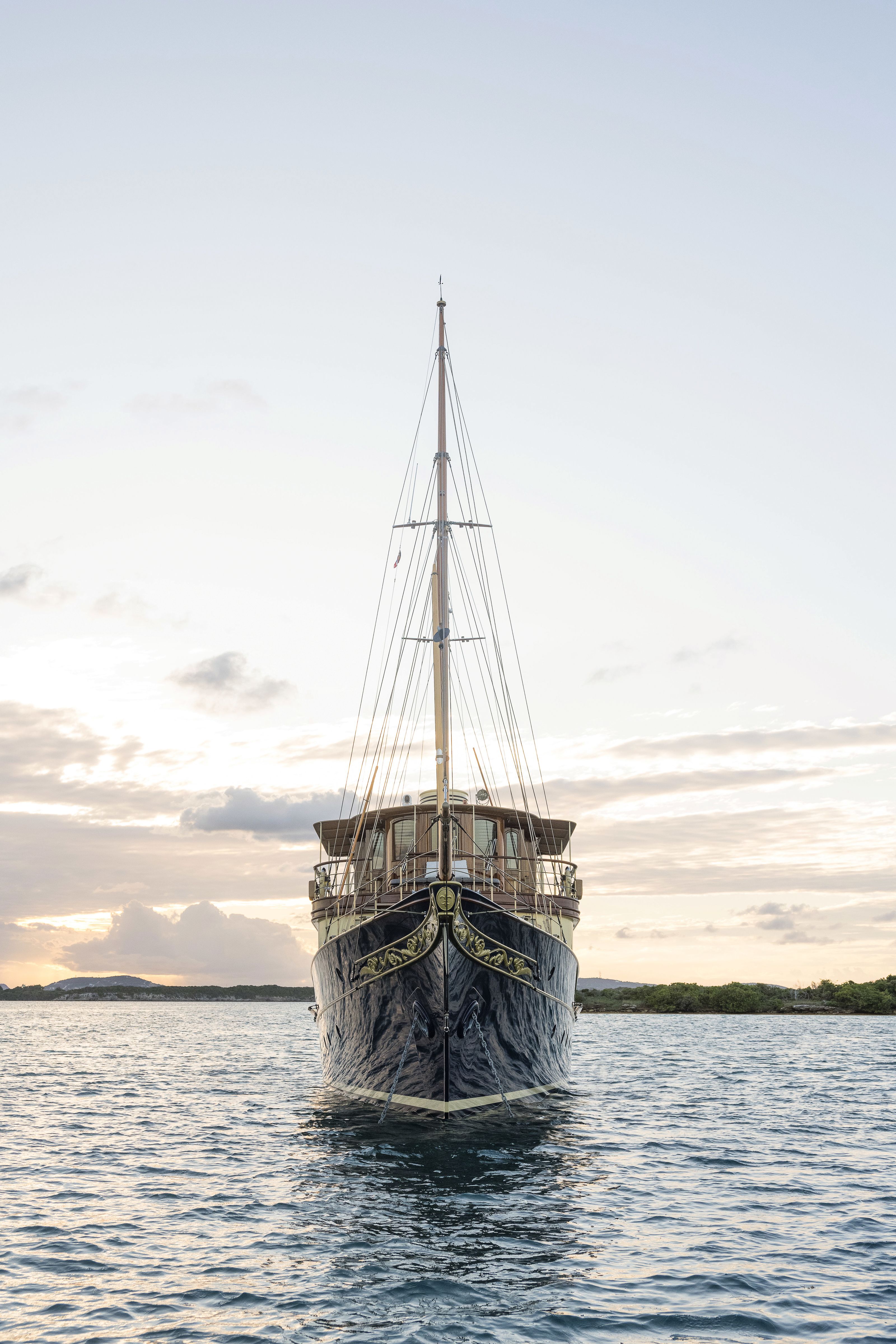
CORY SILKEN
CORY SILKEN
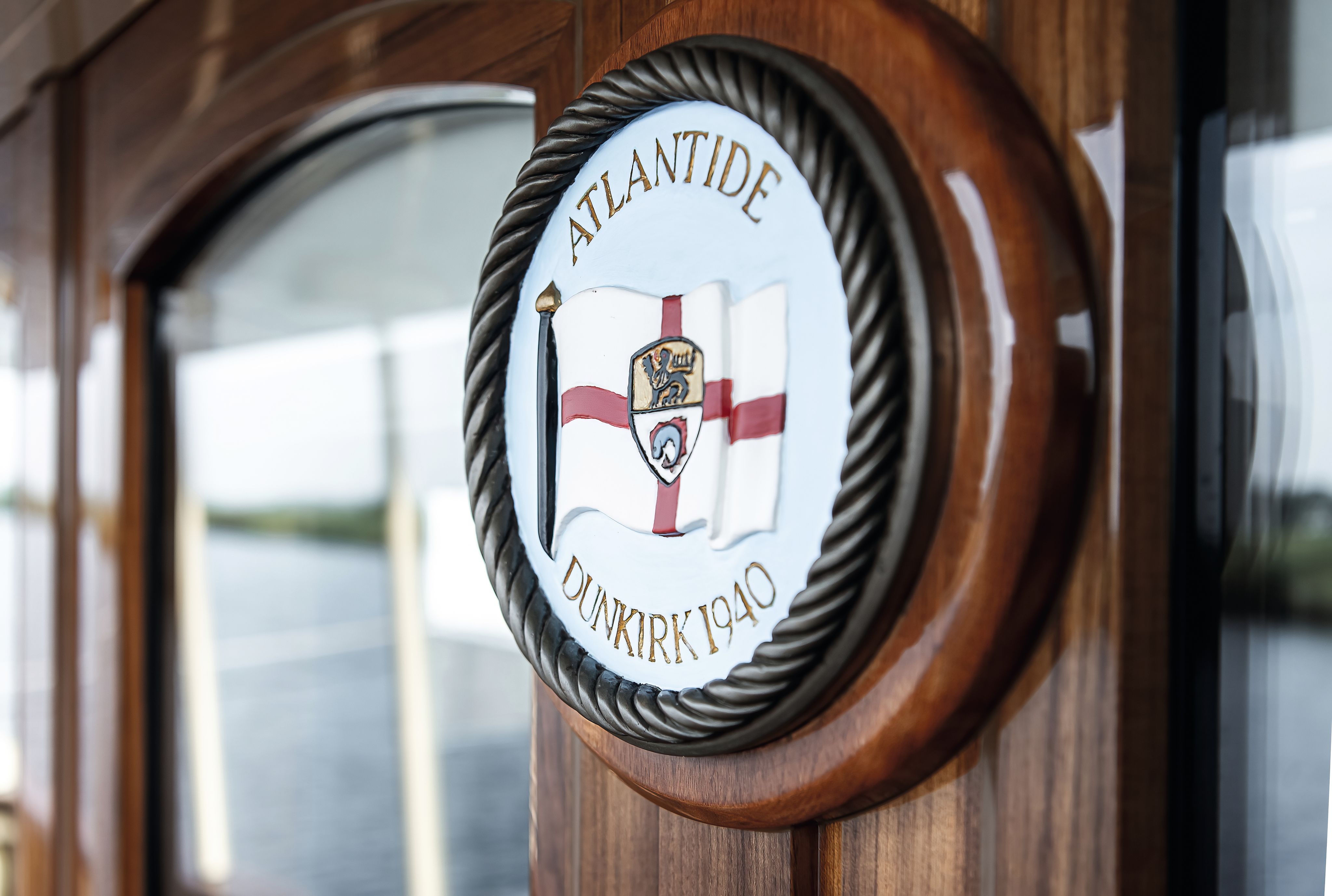
TOM VAN OOSSANEN
TOM VAN OOSSANEN
Gleaming after a refit at Huisfit, Atlantide commemorates her role in wartime heritage. She was built in 1930 for Sir Thomas Lipton
IMAGES: BETTMAN / GETTY IMAGES, CORY SILKEN, TOM VAN OOSSANEN
But in the case of Llanthony, it wasn’t her Dunkirk service, in a straightforward sense, that attracted the yacht’s current owner: “That came later, as a fascinating addition to her story,” says Dennett. “It was the boat itself: something about her proportions, her past, her mystery.”
When, in 2004, Tara Getty bought 31.6-metre Blue Bird of 1938, he bought into an even greater mystery. Blue Bird was built in a commercial shipyard, the Goole Shipbuilding and Repairing Company, in Yorkshire, for Sir Malcolm Campbell, the holder of the world land and speed records at that time. Goole did not build yachts; it built trawlers, barges and military vessels.
But Campbell wanted a yacht that could cross oceans and go anywhere. The reason? Lost treasure.
Blue Bird of 1938 was one of more than 60 Dunkirk Little Ships that retraced their 1940 journey this year
Blue Bird of 1938 was one of more than 60 Dunkirk Little Ships that retraced their 1940 journey this year
Somewhere on Cocos Island – inspiration for Robert Louis Stevenson’s Treasure Island – 550 kilometres off the Central American Pacific coast, there was reputed to be a great lost treasure stolen from Lima, Peru in 1820. Campbell became obsessed.
He had a yacht built for the sole purpose of returning to the island, only for the Second World War to scupper his plans. All three of his yachts – Chico, Bluebird of Chelsea and Blue Bird of 1938 – were destined for Dunkirk. By the time Blue Bird was decommissioned in 1947, Campbell was too ill to embark on his great voyage for gold.
Blue Bird of 1938 was built by Sir Malcolm Campbell to carry him to Cocos Island for a treasure hunt, but the war interfered with his plans
He died in 1948 but his dream did not. It lived on, untapped, deep within Blue Bird. The dream passed by Jean-Louis Renault, the carmaker, who owned Blue Bird between 1953 and 1978. It was not until Tara Getty sent Blue Bird for a three-year, full renovation in Palma de Mallorca in 2004, that the dream, too, was restored.
COURTESY OF OWNERTara Getty, owner of Dunkirk
COURTESY OF OWNERTara Getty, owner of Dunkirk
And, in 2015, Campbell’s dream was realised. Getty, his wife and their three children sailed to Cocos Island on Blue Bird to search for lost treasure. No treasure was found. But the spirit of Blue Bird was revived. And, in May 2025, Blue Bird sailed alongside Llanthony and more than 60 other little ships from Ramsgate to Dunkirk and back again. Each boat becomes richer in experience and story each year that they meet.
First published in the November 2025 issue of BOAT International. Get this magazine sent straight to your door, or subscribe and never miss an issue.


